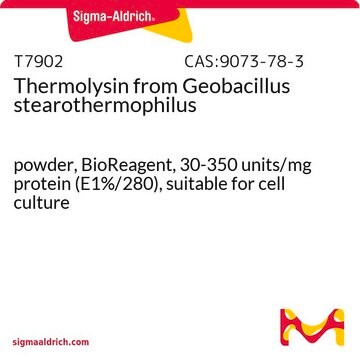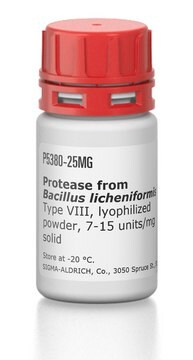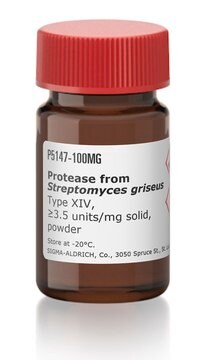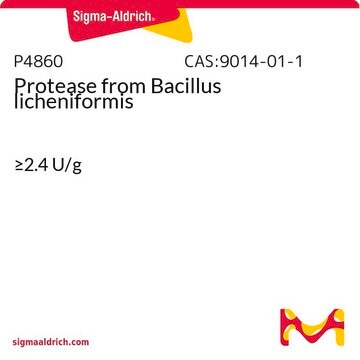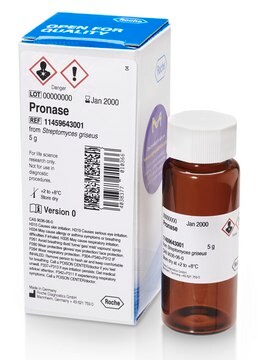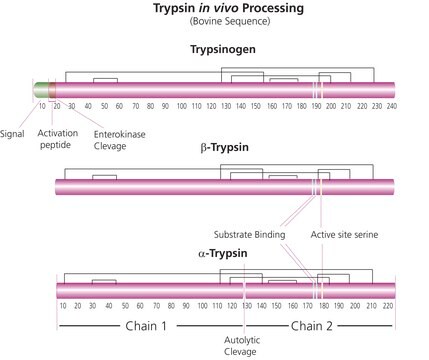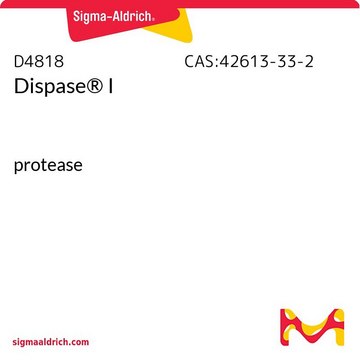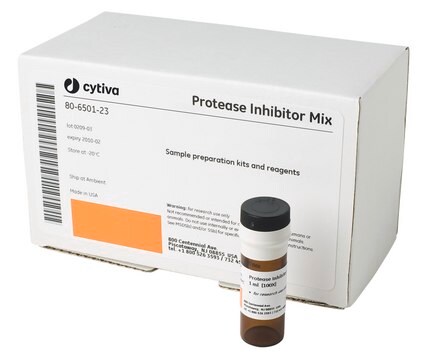P1512
Thermolysin from Geobacillus stearothermophilus
Type X, lyophilized powder, 30-350 units/mg protein (E1%/280)
Synonym(s):
Protease from Geobacillus stearothermophilus, Thermophilic-bacterial protease
Sign Into View Organizational & Contract Pricing
All Photos(1)
About This Item
Recommended Products
biological source
Geobacillus stearothermophilus
Quality Level
type
Type X
form
lyophilized powder
specific activity
30-350 units/mg protein (E1%/280)
mol wt
34.6 kDa by amino acid sequence
purified by
crystallization
shipped in
wet ice
storage temp.
−20°C
Related Categories
General description
Thermolysin is a protease that has specificity different from other proteases available for sequence investigations.
Application
A thermostable (thermophilic) extracellular metalloendopeptidase containing four calcium ions. Cofactors are zinc and calcium. Hydrolyzes protein bonds on the N-terminal side of hydrophobic amino acid residues. The pH optimum is 8.0 and the optimal temperature for activity is 70 °C. Considerably stable from pH 5 to 9.5. Thermolysin has a low cleavage specificity, therefore, it produces a number of short fragments that are suitable for sequencing. Preferential cleavage: X-cleavage-Y-Z where X=any amino acid; Y=Leu, Phe, Ile, Val, Met, Ala and Z is any amino acid other than Pro. Cleavage N-terminal to Leu is preferred over cleavage of N-terminal to Phe which is preferred over the others. Often used to do limited proteolysis for peptide mapping and studies of protein structure and conformational changes.
Thermolysin has been shown to have a prosequeence that acts as an intramolecular chaperone in vivo. It has also been used in a study to investigate the effects of sodium chloride on thermal stability and catalytic activity.
Thermolysin is also commonly used for the commercial synthesis of N-(benzyloxycarbonyl)-L-aspartyl-L-phenylalanine methyl ester, the precursor for the artificial sweetener aspartame.
Quality
Contains many extraneous enzymes.
Unit Definition
One unit will hydrolyze casein to produce color equivalent to 1.0 μmole (181 μg) of tyrosine per min at pH 7.5 at 37 °C (color by Folin-Ciocalteu reagent).
Physical form
lyophilized powder containing calcium and sodium acetate buffer salts
Preparation Note
The pH optimum is 8.0 and the optimal temperature for activity is 70 °C. Considerably stable from pH 5 to 9.5. Thermolysin has a low cleavage specificity, therefore, it produces a number of short fragments that are suitable for sequencing. Preferential cleavage: X-cleavage-Y-Z where X=any amino acid; Y=Leu, Phe, Ile, Val, Met, Ala and Z is any amino acid other than Pro. Cleavage N-terminal to Leu is preferred over cleavage of N-terminal to Phe which is preferred over the others.
Signal Word
Danger
Hazard Statements
Precautionary Statements
Hazard Classifications
Resp. Sens. 1
Storage Class Code
11 - Combustible Solids
WGK
WGK 3
Flash Point(F)
Not applicable
Flash Point(C)
Not applicable
Personal Protective Equipment
dust mask type N95 (US), Eyeshields, Gloves
Choose from one of the most recent versions:
Already Own This Product?
Find documentation for the products that you have recently purchased in the Document Library.
Customers Also Viewed
K Inouye et al.
Biochimica et biophysica acta, 1388(1), 209-214 (1998-10-17)
Thermolysin, a thermophilic metalloproteinase, is markedly activated in the presence of high concentrations (1-5 M) of neutral salts. The activity increases in an exponential fashion with increasing salt concentration, and is enhanced 13-15 times with 4 M NaCl at pH
The use of thermolysin in amino acid sequence determination.
R P Ambler et al.
The Biochemical journal, 108(5), 893-895 (1968-08-01)
M Miyanaga et al.
Biotechnology and bioengineering, 46(6), 631-635 (1995-06-20)
N-(benzyloxycarbonyl)-L-aspartyl-L-phenylalanine methyl ester, a precursor of the synthetic sweetener, aspartame, was synthesized from N-(benzyloxycarbonyl)-L-aspartic acid and L-phenylalanine methyl ester with an immobilized thermolysin (EC 3.4.24.4) in the mixed organic solvent system of tert-amyl alcohol and ethyl acetate. A mixed solvent
Balbir K Chaal et al.
Methods in molecular biology (Clifton, N.J.), 390, 207-217 (2007-10-24)
All the algae with chlorophyll (Chl) c (haptophytes, cryptophytes, and heterokonts such as diatoms) acquired their chloroplasts by secondary endosymbiosis, where a nonphotosynthetic eukaryote host engulfed (or was invaded by) a red alga. This resulted in chloroplasts with four bounding
Haley Marshall et al.
Acta crystallographica. Section D, Biological crystallography, 68(Pt 1), 69-81 (2011-12-24)
Both crystallization and cryoprotection are often bottlenecks for high-resolution X-ray structure determination of macromolecules. Methylamine osmolytes are known stabilizers of protein structure. One such osmolyte, trimethylamine N-oxide (TMAO), has seen occasional use as an additive to improve macromolecular crystal quality
Protocols
To standardize a procedure for the enzymatic assay of Protease using Casein as a substrate.
Our team of scientists has experience in all areas of research including Life Science, Material Science, Chemical Synthesis, Chromatography, Analytical and many others.
Contact Technical Service